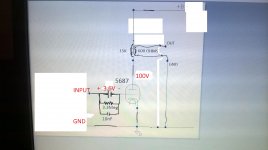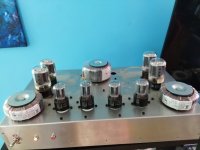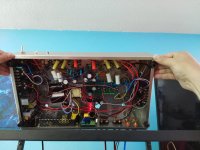I usually use DC, mostly because I usually use an SMPS for the heaters... However, I also built a cheap amp using "junkbox" parts that used AC heaters and there was no audible difference (no hum).
I could never discern any audible difference but you have to be careful with layout of the high current heater wiring.
If the valves are not faulty, AC is the best source, with a null adjustment for minimum hum, (if any).
Subjectively speaking AC heaters sounds more direct & fast but I didn't compared with the same schematic.
AC heating should be fine for this application, but make sure to twist the heater wiring and route it away from everything else, if the filament winding is not center tapped create an artificial one with a pair of 100 ohm resistors in series across the heater winding, and ground the point between the resistors.
I use DC heating in phono stages and any DHT based amplifier circuitry, and some line stage circuitry.
I use DC heating in phono stages and any DHT based amplifier circuitry, and some line stage circuitry.
I like AC heating whenever I can use it, save for phono/RIAA and super low level DAC I/V types of circuits, or the occasional musical instrument amplifier use. I only deviate if DC will be easier to implement, such as if you are already using low level DC for other circuitry and it's easier to simply use that, which can improve regulator performance by pulling more current anyway.
The manual twisting of the heater wiring is enough for me to use DC 🙂 Hand twisting 22 solid core isn't very fun, and an SMPS is cheaper than a transformer, bridge, CLCRC filter.
If I hand twisted I'd go that route too, but I use a drill. 😀 I've had problems in the past with noisy filament SMPS so I either use AC or linear regs.
When I need to run AC heaters I use UTP from a CAT5 Ethernet cable... Works great if you run separate runs, 28AWG isn't good past about 1 Ampere. I use chassis ground, so running DC saves some wire, too.
I don't use the chassis as a return for either AC or DC filaments, this seems to have been an acceptable practice in guitar amps and radios decades ago. I don't use the chassis for signal ground either. (I do connect it at one point to circuit ground) I also pretty much put everything on PCB these days..
All mine are 1950s style chassis grounded for safety, signal, and B+ return, all point to point wired. They kind of look like the under chassis of an old RCA colour TV!
I use aluminum as it's not ferromagnetic, and is a pretty good conductor (compared to steel, anyway).
Here's one I build with 12AV5GA outputs triode connected.
The SMPS on the left side powers the boost converter (bottom right) for 440V for the signal stages, the SMPS on the bottom left in the cage powers the heaters. The power is 230VAC rectified to 330VDC for the output stage.
I use aluminum as it's not ferromagnetic, and is a pretty good conductor (compared to steel, anyway).
Here's one I build with 12AV5GA outputs triode connected.
The SMPS on the left side powers the boost converter (bottom right) for 440V for the signal stages, the SMPS on the bottom left in the cage powers the heaters. The power is 230VAC rectified to 330VDC for the output stage.
Attachments
Last edited:
So why do some people swear by regulated DC powered heaters? Are they hearing something different to those who prefer AC heating?
If they hear a difference they are either hearing hum from AC heating, or they are dreaming IMHO. I just use DC because it's easier and cheaper for me.
In very low level circuitry it definitely makes a difference such as a phono, tape amplifier or I/V converter, otherwise I mostly heat with AC. (Note that noisy DC with 120Hz ripple may well be worse than AC!)
In the case of DHTs it makes a pretty big difference particularly with 5V filaments and above. AC heating in DHTs results in measurable intermodulation distortion at 2x the fundamental which you can see as side tones on the fundamental in an FFT measurement - this is measurable even with 2.5V filaments although I cannot say I hear it. There are ways to minimize it, but it's there. I would post new measurements (I can now easily measure with my RTX) but I don't currently have such an amplifier in house.
Koda, very nice clean looking build. I use aluminum chassis for the same basic reasons you state, but don't use them as ground references anymore. (I did at one time)
In the case of DHTs it makes a pretty big difference particularly with 5V filaments and above. AC heating in DHTs results in measurable intermodulation distortion at 2x the fundamental which you can see as side tones on the fundamental in an FFT measurement - this is measurable even with 2.5V filaments although I cannot say I hear it. There are ways to minimize it, but it's there. I would post new measurements (I can now easily measure with my RTX) but I don't currently have such an amplifier in house.
Koda, very nice clean looking build. I use aluminum chassis for the same basic reasons you state, but don't use them as ground references anymore. (I did at one time)
Thank you, Kevin. It's one of the neater ones, that's for sure. I made an integrated amp in a 2" high chassis with a line stage, two buffer stages, a phono stage, and an EL34 output stage with VR regulated screns for a total of 22 tubes (separate power supply), complete with relay switched inputs and a relay based attenuator. It's a rat's nest but it works perfectly...Koda, very nice clean looking build.
- Status
- Not open for further replies.
- Home
- Amplifiers
- Tubes / Valves
- Filaments DC or AC?


